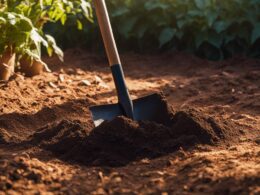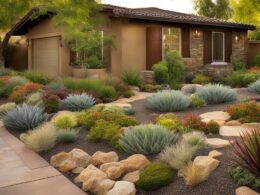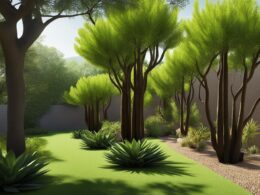Are you interested in creating a sustainable and environmentally-friendly garden that conserves water? Look no further than xerophytic gardening! Xerophytes, which are drought-resistant plants, can thrive in low-water conditions and offer numerous benefits for your garden. Whether you want to save time, money, or contribute to water conservation efforts, planning a water-efficient garden with xerophytes is the way to go.
Key Takeaways
- Water-efficient garden planning involves using xerophytes, drought-resistant plants.
- Xerophytes have adaptations that help them thrive in low-water conditions.
- By planning a xerophytic garden, you can save time, money, and help conserve water.
- Xerophytic gardens create sustainable and environmentally-friendly landscapes.
- Implementing a water-efficient garden can be done anywhere, not just in arid regions.
What Are Xerophytes?
Xerophytes are a fascinating group of plants that have remarkable adaptations to thrive in drought conditions. These water-efficient plants have evolved unique features that enable them to minimize water loss and survive in harsh climates. Xerophytes play a crucial role in water conservation and sustainable gardening practices. Understanding their adaptations can help you create a beautiful and environmentally-friendly garden that conserves water.
One key adaptation of xerophytes is their ability to store water in their fleshy leaves. This enables them to withstand extended periods of drought by utilizing the stored water during dry spells. Xerophytes also have smaller leaves compared to other plants, reducing the surface area through which water can evaporate. This adaptation helps to decrease water loss through transpiration, allowing the plant to conserve water more effectively.
Xerophytes have also developed deep-rooting systems, allowing them to access moisture from deeper soil layers. These extensive root systems enable the plants to survive in dry conditions by reaching water sources that are inaccessible to other plants. Additionally, some xerophytes perform photosynthesis in the evening when temperatures are lower and moisture loss is reduced. This adaptation helps to conserve water and maximize the plant’s energy absorption.
Furthermore, xerophytes often have coatings on their leaves, such as a waxy or hairy texture, which serves as a protective barrier against excessive sun exposure. These coatings help to reduce water loss through evaporation and prevent damage caused by intense sunlight. By understanding the adaptations of xerophytes, you can select the most suitable plants for your water-efficient garden and create a sustainable and thriving landscape.
“Xerophytes have evolved remarkable features to survive in drought conditions and conserve water. Their ability to store water, reduce transpiration, access moisture through deep-rooting systems, and utilize protective coatings on their leaves make them ideal for water-efficient gardening.”
| Xerophyte Adaptations | Description |
|---|---|
| Water Storage | Xerophytes store water in their fleshy leaves, enabling them to survive in dry spells. |
| Reduced Leaf Size | Xerophytes have smaller leaves, minimizing water loss through transpiration. |
| Deep-Rooting Systems | These plants have extensive root systems that allow them to access moisture from deeper soil layers. |
| Evening Photosynthesis | Some xerophytes perform photosynthesis in the evening to conserve water and optimize energy absorption. |
| Leaf Coatings | Xerophytes have coatings on their leaves that protect against excessive sun exposure and reduce water loss. |
Benefits of Xerophytic Garden Design
Designing a xerophytic garden offers numerous benefits, with water conservation and sustainable landscaping being at the forefront. By implementing xerophytic plants and design principles, you can significantly reduce your water usage while creating a beautiful and environmentally-friendly outdoor space.
Xerophytic garden design is an effective way to conserve water, particularly in regions where water resources are limited. By replacing traditional lawns or barren ground with xerophytic plants, you can significantly reduce or eliminate the need for daily watering. These plants have evolved to thrive in low-water conditions, making them an ideal choice for water-efficient gardens.
Furthermore, xerophytic gardens contribute to sustainable landscaping by embracing the natural conditions of your region. By using plants that are well-suited to the local climate, you can reduce the need for excessive maintenance, such as frequent watering, fertilizing, and pest control. This not only saves time and effort but also reduces the use of harmful chemicals, promoting a healthier and more eco-friendly approach to gardening.
In addition to water conservation and sustainability, xerophytic gardens also provide habitats for native wildlife. These gardens offer shelter, food, and shade for various species, attracting birds, butterflies, and beneficial insects. By creating a xerophytic garden, you can contribute to the conservation of local wildlife and promote a balanced ecosystem.
Xerophytic Garden Design Benefits:
- Water conservation
- Sustainable landscaping
- Reduced maintenance
- Promotion of native wildlife habitat
| Benefits | |
|---|---|
| Water Conservation | By using xerophytic plants and design principles, you can significantly reduce water usage in your garden. |
| Sustainable Landscaping | Xerophytic gardens embrace the natural conditions of your region, reducing the need for excessive maintenance and harmful chemicals. |
| Reduced Maintenance | Xerophytic gardens require less maintenance, saving time, effort, and resources. |
| Promotion of Native Wildlife Habitat | By creating a xerophytic garden, you provide a habitat for native wildlife, contributing to biodiversity and ecosystem balance. |
Planning a Xerophytic Garden
When it comes to planning a xerophytic garden, the first step is to assess the land and your specific needs. Understanding the existing conditions of your garden, such as sunlight exposure, wind patterns, and permanent structures, will help you select suitable plant species that thrive in your specific growing conditions. Additionally, consider making a list of your goals and preferences for the garden design, such as replacing a lawn, creating beds, or filling barren ground.
One important aspect of planning a xerophytic garden is selecting native plants and drought-tolerant species. Native plants are well-adapted to the local climate and require minimal watering, making them ideal choices for water-efficient gardening. Drought-tolerant species, on the other hand, are specifically designed to thrive in low-water situations. By grouping plants together based on their moisture requirements, you can create a more efficient and sustainable garden.
Another consideration in planning your xerophytic garden is the layout. Determine areas of shade, water collection or drainage, and potential areas of erosion. This information will help you design an efficient irrigation system and choose suitable locations for different plant species. Taking the time to plan your xerophytic garden properly will ensure its long-term success and provide you with a beautiful and sustainable outdoor space.
Table: Examples of Native Plants for Xerophytic Gardens
| Plant Name | Water Requirements | Sunlight Exposure |
|---|---|---|
| Yucca | Low | Full sun |
| Agave | Low | Full sun |
| Penstemon | Low to medium | Full sun to partial shade |
| Lavender | Low to medium | Full sun |
Table: Examples of native plants suitable for xerophytic gardens, along with their water requirements and sunlight exposure.
Xerophytic Gardening Design Guide
In order to create a water-efficient garden with xerophytic plants, it is important to follow a comprehensive design guide. This guide will help you make informed decisions about plant selection, layout, and consider environmental factors specific to your property and region. By following these steps, you can create a thriving xerophytic garden that conserves water and enhances your outdoor space.
Choosing Xerophytic Plants
When selecting xerophytic plants for your garden, it is important to choose species that are well-adapted to your climate and soil conditions. Look for plants that have characteristics such as deep-rooting systems, fleshy leaves for water storage, and smaller leaves to reduce water loss. Consider using native xerophytes as they are often better suited to the local climate and require less maintenance.
Considering Layout and Environmental Factors
When planning the layout of your xerophytic garden, take into account the natural features of your property. Assess the areas of sunlight exposure, shade, water collection or drainage, and wind patterns. This will help you determine which plants will thrive in each area and how to group them based on their moisture requirements. Additionally, consider incorporating elements such as rocks or mulch to help retain soil moisture and reduce evaporation.
Implementing Water-saving Techniques
There are several water-saving techniques that can be implemented in a xerophytic garden. These include efficient irrigation methods such as drip irrigation, which delivers water directly to the roots of plants, reducing water waste. Mulching is another technique that can help retain soil moisture and reduce weed growth. By utilizing these techniques, you can minimize water usage in your garden and create a sustainable, water-efficient landscape.
| Xerophytic Plants | Characteristics |
|---|---|
| Succulents | Fleshy leaves for water storage |
| Agave | Deep-rooting system |
| Lavender | Drought-tolerant with aromatic flowers |
| Yucca | Tall, spiky leaves with water-storing capacity |
By following this xerophytic gardening design guide, you can create a beautiful and sustainable garden that conserves water. With careful plant selection, thoughtful layout planning, and the implementation of water-saving techniques, your xerophytic garden will thrive while minimizing water usage and enhancing your outdoor space.
Xeriscaping: The Broader Concept
When it comes to water conservation and creating environmentally-friendly landscapes, xeriscaping goes beyond just xerophytic gardening. Xeriscaping is a holistic approach to landscaping that focuses on proper plant selection, efficient water usage, and overall sustainability. By implementing xeriscaping techniques, you can create a beautiful and water-efficient garden that thrives in any climate.
One of the key aspects of xeriscaping is the importance of proper plant selection. By choosing plants that are well-adapted to your specific climate and soil conditions, you can minimize water usage and reduce maintenance requirements. Xeriscaping encourages the use of native or drought-tolerant plants that have evolved to thrive in the local environment. These plants are naturally more resistant to drought, requiring less water to survive and thrive.
Another principle of xeriscaping is grouping plants with similar moisture requirements together. By grouping plants with similar water needs, you can create efficient irrigation zones in your garden. This allows you to water each zone appropriately, ensuring that plants receive the right amount of water without wastage. Grouping plants also helps create a visually appealing landscape by creating areas of color and texture that complement each other.
“Xeriscaping is not just about selecting the right plants; it’s also about using water-saving techniques such as mulching. By applying mulch to the soil surface, you can reduce evaporation, suppress weed growth, and improve soil moisture retention. Organic mulches, such as wood chips or compost, are particularly effective because they break down over time, enriching the soil.”
In addition to proper plant selection and grouping, xeriscaping promotes the use of alternative ground covers to reduce the need for traditional turf grass. Turf grass requires significant amounts of water to maintain its lush appearance, making it one of the major contributors to water waste in traditional landscapes. By replacing turf grass with alternatives such as native groundcovers, gravel, or permeable paving, you can create a more sustainable and water-efficient garden.
The Benefits of Xeriscaping:
- Conserves water and reduces water bills
- Requires less maintenance and saves time
- Creates a more sustainable and environmentally-friendly garden
- Reduces the need for chemical fertilizers and pesticides
- Provides habitats for native wildlife
The Principles of Xeriscaping:
- Proper plant selection based on climate and soil conditions
- Efficient irrigation with zoning and proper watering techniques
- Grouping plants with similar moisture requirements
- Mulching to conserve water and suppress weeds
- Replacing traditional turf grass with water-saving alternatives
By embracing xeriscaping principles and implementing water-saving techniques, you can create a beautiful and sustainable garden that conserves water and protects the environment. Whether you have a small residential garden or a large-scale landscape, xeriscaping is a practical and responsible choice that allows you to enjoy your outdoor space while minimizing water waste.
| Xeriscaping Benefits | Xeriscaping Principles |
|---|---|
| Conserves water and reduces water bills | Proper plant selection based on climate and soil conditions |
| Requires less maintenance and saves time | Efficient irrigation with zoning and proper watering techniques |
| Creates a more sustainable and environmentally-friendly garden | Grouping plants with similar moisture requirements |
| Reduces the need for chemical fertilizers and pesticides | Mulching to conserve water and suppress weeds |
| Provides habitats for native wildlife | Replacing traditional turf grass with water-saving alternatives |
Shade-Loving Xeriscaping
Xeriscaping, typically associated with arid environments, can also be applied to shade-loving plants in areas with damp soil. This variation, known as shade-loving xeriscaping or woodland gardening, offers an excellent solution for creating a water-efficient and low-maintenance garden in lush environments. By harnessing the natural shade provided by mature trees and implementing moisture retention techniques, you can cultivate a thriving garden while conserving water.
To successfully implement shade-loving xeriscaping, plant selection is key. Opt for shade-loving xerophytes and native plants that thrive in moist conditions. These plants have adapted to flourish in areas with limited sunlight and higher humidity, making them well-suited for woodland gardening. Some popular choices include ferns, hostas, astilbes, and bleeding hearts. By carefully selecting plants that naturally thrive in the shade, you can create a harmonious and visually appealing garden.
Moisture retention is another important aspect to consider in shade-loving xeriscaping. Use organic mulch, such as leaf litter or bark chips, to help retain moisture in the soil and prevent evaporation. Mulching also aids in weed suppression and improves soil structure. Apply a layer of mulch around the base of each plant, ensuring not to pile it up against the stem or trunk to avoid moisture-related issues.
When implementing shade-loving xeriscaping, it’s essential to strike a balance between water conservation and plant health. While shade-loving plants typically require less water than sun-loving varieties, it’s important to monitor soil moisture levels and provide supplemental watering as needed. Be mindful of overwatering, as excessive moisture can lead to root rot and other plant health problems. Regularly check the soil’s moisture content and adjust watering accordingly to ensure the optimal growth of your shade-loving xeriscaped garden.
| Benefits of Shade-Loving Xeriscaping | Considerations for Shade-Loving Xeriscaping |
|---|---|
|
|
Xerophytes for Different Styles
One of the great advantages of xerophytes is their ability to be incorporated into various garden styles, including tropical gardens, English gardens, formal gardens, and native gardens. By choosing the right xerophytic plants that are well-suited to the specific style and climate of your garden, you can create a stunning and water-efficient landscape that perfectly complements your outdoor space.
In tropical gardens, xerophytes such as succulents and cacti can thrive in the heat and humidity, providing a unique and exotic look. Their ability to store water makes them excellent choices for tropical climates where rainfall may be abundant but sporadic. Add a touch of vibrancy and texture to your garden with striking succulents and drought-tolerant cacti.
English and formal gardens, known for their tidy and manicured appearance, can also benefit from the use of xerophytes. Choose native or drought-tolerant plants that require minimal watering and have a refined and classic aesthetic. These plants will not only conserve water but also add elegance and structure to your garden design.
For those looking to create a more ecological and sustainable landscape, native gardens are the way to go. Incorporating xerophytic plants that are indigenous to your area not only helps conserve water but also supports local ecosystems. Native gardens attract pollinators, provide food and shelter for wildlife, and promote biodiversity. Research the native xerophytic plants that are well-adapted to your region and let them flourish in your garden.
| Garden Style | Xerophytic Plant Recommendations |
|---|---|
| Tropical Gardens | Succulents, cacti |
| English Gardens | Native plants, drought-tolerant species |
| Formal Gardens | Drought-tolerant plants, low-water species |
| Native Gardens | Indigenous xerophytes, drought-resistant varieties |
Maintaining a Xerophytic Garden
Once you’ve created your beautiful xerophytic garden, it’s important to maintain it properly to ensure its long-term success. Regular maintenance tasks will help your garden thrive and continue to conserve water. Here are some essential maintenance practices for your xerophytic garden:
1. Watering
While xerophytes are adapted to survive with minimal water, newly planted specimens and juvenile plants will still require watering. It’s vital to provide adequate water during their establishment period, typically the first year. Once established, water your xerophytic garden sparingly, focusing on deep watering to encourage deep root growth. This will promote the plant’s drought resistance and reduce overall water needs.
2. Pruning
Regular pruning is necessary to maintain the shape and health of your xerophytic plants. Prune dead or damaged branches, remove any overcrowded growth, and shape the plants as needed. Pruning also helps stimulate new growth and prevents the accumulation of dead material, which can become a fire hazard in dry climates.
3. Mulching
Applying a layer of mulch around your xerophytic plants is essential for moisture retention and weed suppression. Mulch helps conserve soil moisture by reducing evaporation and keeps the soil cool. Use organic materials such as wood chips, straw, or bark mulch, applying a layer about 2 to 3 inches deep. Avoid piling mulch against the plant stems to prevent rot or disease.
4. Drip Irrigation
Drip irrigation is a highly efficient method for watering xerophytic gardens. It delivers water directly to the root zone, minimizing water loss through evaporation or runoff. Install a drip irrigation system with emitters placed near the base of each plant. This will provide slow, consistent water delivery, allowing the plants to absorb moisture without wasting water.
| Maintenance Practice | Frequency |
|---|---|
| Watering | Regularly during establishment, sparingly once established |
| Pruning | As needed to maintain shape and remove dead or damaged branches |
| Mulching | Apply a layer of mulch about 2 to 3 inches deep |
| Drip Irrigation | Use a drip irrigation system for efficient watering |
By following these maintenance practices, you can ensure the health and beauty of your xerophytic garden while conserving water. Remember to tailor your maintenance routine to the specific needs of your plants and the local climate. With proper care, your xerophytic garden will continue to thrive and be a sustainable oasis for years to come.
Xeriscaping on a Grand Scale
When it comes to creating a visually stunning and water-efficient landscape on a large scale, xeriscaping is the way to go. By incorporating drought-tolerant trees and shrubs and implementing a layered arrangement of plants, you can achieve a grand-scale xeriscaped garden that is both eco-friendly and visually captivating.
Drought-tolerant trees and shrubs are essential components of a grand-scale xeriscaping project. These plants have adapted to survive in low-water conditions, making them ideal for water-conscious landscaping. Examples of drought-tolerant trees include the Desert Willow, Palo Verde, and Olive trees, while shrubs such as Agave, Yucca, and Russian Sage can add texture and interest to the landscape.
A layered arrangement of plants is another key factor in creating a visually appealing grand-scale xeriscaped garden. By grouping plants with similar water needs together, you can create efficient irrigation zones that maximize water usage. For example, you can create a low-water zone with succulents and cacti, a moderate-water zone with ornamental grasses, and a higher-water zone with flowering shrubs. This layered approach not only conserves water but also adds depth and visual interest to the landscape.
Implementing xeriscaping on a grand scale requires careful planning and consideration of the site’s specific environmental factors. Analyze the soil conditions, sunlight exposure, and existing water sources to determine the most suitable plants and irrigation methods for your landscape. By creating a well-designed xeriscaped garden, you can achieve a beautiful and sustainable landscape that conserves water and reduces maintenance needs.
| Benefits of Xeriscaping on a Grand Scale | Examples of Drought-Tolerant Trees and Shrubs |
|---|---|
|
|
Conclusion
In conclusion, creating a water-efficient garden with xerophytes is a sustainable landscaping choice that offers numerous benefits. By incorporating these drought-resistant plants into your garden, you can conserve water and contribute to a more environmentally responsible landscape.
With the principles of xerophytic gardening, such as appropriate plant selection, efficient irrigation, proper mulching, and thoughtful design, you can create a beautiful and resilient garden that thrives with minimal water. Whether you have a small residential garden or a large-scale landscape, implementing xerophytic gardening techniques is a practical way to save water and create a visually appealing outdoor space.
Start planning your water-efficient garden with xerophytes today, and enjoy the beauty of nature while making a positive impact on the environment. Embrace sustainable landscaping practices and contribute to a greener and more water-conscious future.
How Can Xerophytes and Native Plants Help Create a Water-Efficient Garden?
Xerophytes, such as succulents and cacti, alongside native plants for lowwater gardens can significantly reduce water usage in a garden. Their ability to thrive in arid conditions means they require minimal irrigation, making them an ideal choice for creating a water-efficient and sustainable outdoor space.
FAQ
What are xerophytes?
Xerophytes are plant species that require less water to thrive in harsh climates and drought conditions.
What are the benefits of xerophytic garden design?
Xerophytic gardens help conserve water, create sustainable landscapes, and provide habitats for native wildlife.
How do I plan a xerophytic garden?
Assess your land and specific needs, understand the existing conditions, and select suitable plant species based on your growing conditions.
Is there a guide for xerophytic gardening design?
Yes, a comprehensive design guide provides step-by-step instructions on selecting plants, considering environmental factors, and implementing water-saving techniques.
What is the difference between xerophytic gardening and xeriscaping?
Xeriscaping is a broader concept that includes landscaping practices to conserve water, while xerophytic gardening specifically focuses on using water-efficient plants.
Can xeriscaping be implemented in areas with shade and damp soil?
Yes, shade-loving xeriscaping techniques can be applied to create low-maintenance gardens in lush environments.
Can xerophytes be incorporated into different garden styles?
Yes, xerophytes can be incorporated into various garden styles, including tropical, English, formal, and native gardens.
How do I maintain a xerophytic garden?
Regular maintenance tasks include watering, pruning, mulching, and using drip irrigation to ensure the long-term success of the garden.
Can xeriscaping be implemented on a large scale?
Yes, by selecting drought-tolerant plants, creating layered arrangements, and incorporating ornamental grasses, xeriscaping can be implemented on a grand scale in large landscapes.














